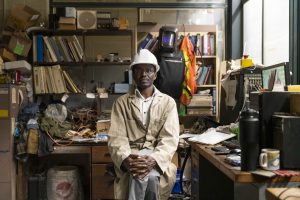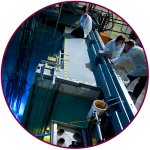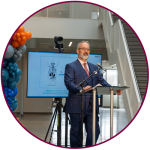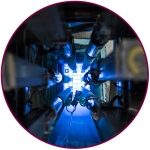
October 16, 2023
Celebrating Nuclear Science Week at McMaster
October 16-20, 2023
___
International Nuclear Science Week is a time to celebrate nuclear research, education and impact.
McMaster is home to a unique suite of nuclear research facilities – anchored by the McMaster Nuclear Reactor – where students and faculty are leading the next-generation of innovations in nuclear science.
Register for Nuclear Science Week events on campus and learn more about the McMaster Nuclear Reactor below.
Stay tuned to this page for updates throughout the week.
Nuclear Now: Students network with nuclear industry leaders and grads

“There is a huge demand for talent across the board in the nuclear industry, especially as Canada and the world look to nuclear energy to help us achieve net zero,” says Dave Tucker, Chief Nuclear Officer and Associate Vice-President, Nuclear. “Students at McMaster have a unique opportunity to gain experience and build connections in nuclear to become tomorrow’s leaders in the field.”
Click here to learn more about the Nuclear Now career panel recap.
Nuclear Science Week Community Day
Monday, October 16 | 7:00 – 9:00 PM
Nuclear Operations & Facilities welcomes visitors to tour three of our nuclear facilities, including the McMaster Nuclear Reactor, and participate in hands-on educational nuclear science activities. Discover how we safely produce life-saving medical isotopes and conduct research in advanced materials, clean energy and more.
Register for the Community Day.
Nuclear Now: Voices of Young Talent in the Nuclear Industry
Thursday, October 19 | 4:30 – 7:00 PM
Attend a panel discussion featuring McMaster alumni with careers in nuclear, learn more about student research and job opportunities in the field and network with nuclear industry professionals.
Go behind-the-scenes at McMaster’s nuclear facilities
All week!
Nuclear Operations & Facilities will be taking over McMaster’s Instagram stories for Nuclear Science Week. Head over to @mcmasteru for a tour of McMaster’s nuclear facilities.

Concrete solutions for Small Modular Reactors

Growing up in a riverside town in Chad, Ousmane Hisseine watched turbulent waters flatten hundreds of mud homes every year, while a nearby concrete bridge stood fast.
That bridge in north-central Africa sparked a lifelong interest in using engineering to improve safety.
Now an assistant professor of civil engineering at McMaster, Hisseine is using his expertise in concrete infrastructure to overcome modern-day limitations in nuclear energy as one of four McMaster researchers to receive the NSERC-CNSC Small Modular Reactors Research Grant Initiative.
Nuclear in the News

Undergraduate students spend an eye-opening summer doing nuclear research

The Big Idea: Bring Nuclear Power Back

McMaster awarded over $1M for research on small modular reactors

Nuclear energy would be a clean win for remote and northern communities

McMaster and medical isotope partners awarded $35M from federal government

New manufacturing facility at MIP will advance next-generation cancer therapies

McMaster receives funding to ramp up medical isotope production

Ask a McMaster expert: Net zero carbon campus

Safer, cleaner nuclear energy for remote communities

Nuclear @ McMaster
What is the McMaster Nuclear Reactor (MNR) used for?
MNR provides neutrons for medical isotope production and scientific research in health and medicine, nuclear safety, clean energy, materials and environmental science.
When was the reactor built?
The reactor was built in 1959. It was the first nuclear reactor built on a university campus in the British Commonwealth and remains Canada’s largest nuclear research reactor today.
Why does the reactor core glow blue?
MNR’s core glows blue due to a process called Cherenkov radiation. In the reactor pool, radiation causes particles to travel faster than light can travel through water. These fast-moving particles excite the electrons of the water molecules, which release energy in the form of photons, or light, creating a blue glow.
Take a virtual tour of the McMaster Nuclear Reactor
What is iodine-125?
MNR is the world’s leading supplier of iodine-125 – a medical isotope used to treat prostate and other cancers in over 70,000 patients around the world each year.
What is neutron radiography?
Like x-rays, neutrons can be used to photograph the interior of objects. Over 500,000 jet engine parts are tested at MNR each year using neutron radiography. If you’ve flown in a plane that was built in North America, it was likely safety checked at McMaster.
Did any famous scientists work at the reactor?
Yes! McMaster physics professor Bertram Brockhouse designed a triple-axis neutron spectrometer that earned him the Nobel Prize in Physics in 1994. This device revolutionized the field of materials science and is still used today at neutron scattering centres around the world.
How often does MNR welcome visitors?
Each year, more than 1800 visitors – from elementary and high students to aspiring scientists to Members of Parliament – tour the reactor, discovering the positive impact of nuclear research first-hand.
What other nuclear facilities does McMaster have on campus?
In addition to the reactor, McMaster has three particle accelerators, a cyclotron, a suite of custom-designed hot cells located at the Centre for Advanced Nuclear Systems and 35 nuclear-licensed labs.
